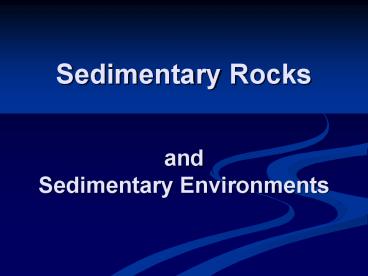Sedimentary Rocks and Sedimentary Environments - PowerPoint PPT Presentation
1 / 38
Title:
Sedimentary Rocks and Sedimentary Environments
Description:
Sedimentary Rocks and Sedimentary Environments Why do we have different kinds of sedimentary rocks on top of each other? Change in the environment of deposition = a ... – PowerPoint PPT presentation
Number of Views:947
Avg rating:3.0/5.0
Title: Sedimentary Rocks and Sedimentary Environments
1
Sedimentary Rocks andSedimentary Environments
2
So, what do we get from weathering?
- Big rocks break into smaller rocks and grains
- Clast is a general term
- (fine material sediment)
- If still large enough, clasts may contain more
than one mineral - Small clasts are generally only one mineral
cobbles
sand grains
Size of clasts
3
Clast Size terms
- Clay (refers to a specific mineral that is often
very fine grained, AND to any very fine grains) - Silt almost all quartz
- Sand quartz with some other minerals
- Pebbles variable mineralogy
- Cobbles variable mineralogy
- Boulders variable mineralogy
Size of clasts
4
So, what do we get from weathering?
- Some minerals are not very stable
- They may dissolve
- Or break down to form other minerals
- Oxidation gt rusty red minerals
- Hydrolysis gt clay minerals
oxidation
clay
Composition
5
Goldichs weathering series
Composition
6
Big picture
7
Stream load
8
Settling velocity
low energy
high energy
9
Big picture (continued)
weathering and erosion
clastic material dissolved material biological
material
transportation
deposition
gravity chem. precipitation
lithification
10
The book sort of combines chemical and biological
11
The most common sedimentary minerals in clastic
rocks
- Quartz
- Clay
Why?
Quartz grains in a sandstone
2 mm
Shales are almost entirely made of Clay, but the
grains are too small To see
12
Olivine beach - Hawaii
13
What kind of sediment collects . . .
- On mountain sides
- Near glaciers
- In sand dunes
- Along rivers
- In lakes
- At deltas
- On beaches
- In lagoons
- In wetlands
- Near reefs
Oysters, Mancos Shale
14
Kinds of sedimentary rocks
rock salt
- Clastic
- Chemical
- Biological
sandstone
limestone
15
Kinds of sedimentary rocks
rock salt
- Clastic
- Chemical
- Biological
sandstone
limestone
16
Deposition in layers
- Bed relatively uniform layer
- E.g., the limestone bed
- Strata an identifiable layer
- May be smaller than a bed
- Formation a rock stratigraphic unit that has
particular characteristics that allow it to be
identified in different places. - May not be completely homogeneous
17
Grand Canyon
18
Grand Canyon Rim
19
Supai Group
20
Massive layers
21
Interbedded layers
22
Laminated rocks
23
Examples of sedimentary rocks
- Breccia
- Conglomerate
- Sandstone
- Shale, etc
- Carbonate
- Evaporite
Almost all clastic material
Generally little clastic material
24
Carbonate rocks
- Called limestone or dolostone
- Or, generically, just limestone
- Most form by precipitation of calcium carbonate
from seawater - Generally in moderate to deep ocean basins
- A few are freshwater
- Some are reef deposits (organic)
- Some contain clastic components
25
Evaporite rocks
- From by evaporation of ocean waters
- Gypsum gt gyp rock
- Halite gt rock salt
26
Examples of sedimentary rocks
- Clastic Sedimentary Rocks
- Breccia
- Conglomerate
- Sandstone
- Shale, etc
- Chemical Sedimentary Rocks
- Carbonate
- Evaporite
27
Kinds of Sedimentary Rocks
- Clastic
- Chemical
- Biological
coal
coquina
28
Kinds of Sedimentary Rocks
- 1. Clastic rocks
shale
conglomerate
sandstone
29
Kinds of Sedimentary Rocks
- 1. Clastic rocks
- 2. Chemical sedimentary rocks
Limestone with fossils
evaporite
evaporite
Rock salt
Gyp rock
30
Salt flats
Halite deposits
31
Gypsum precipitates
Gypsum in red soil
32
Kinds of Sedimentary Rocks
lignite (coal)
- 1. Clastic rocks
- 2. Chemical sedimentary rocks
- 3. Biological sedimentary rocks
anthracite (coal)
Coquina beach rock
Limestone (petrified reef)
33
Examples of sedimentary rocks
- Clastic Sedimentary Rocks
- Breccia
- Conglomerate
- Sandstone
- Shale, etc
- Chemical Sedimentary Rocks
- Carbonate
- Evaporite
- Biological Sedimentary Rocks
- Coal
- Coquina
Named according to grain size and shape
Named according to composition
34
Why do we have different kinds of sedimentary
rocks on top of each other?
- Change in the environment of deposition
- a facies change
35
Transgression and regression
- Transgression increase in ocean depth
- Regression decrease in ocean depth
36
(relative) sea level changes
- Due to climate change
- Uplift of continents
- Downdropping of continents
- Depth of water may change
- Areas may become dry land
- Dry land may flood
37
Sedimentary facies
- Facies environment of deposition
- Different kinds of sediment deposited in
different places at the same time
38
Characteristics of different facies































